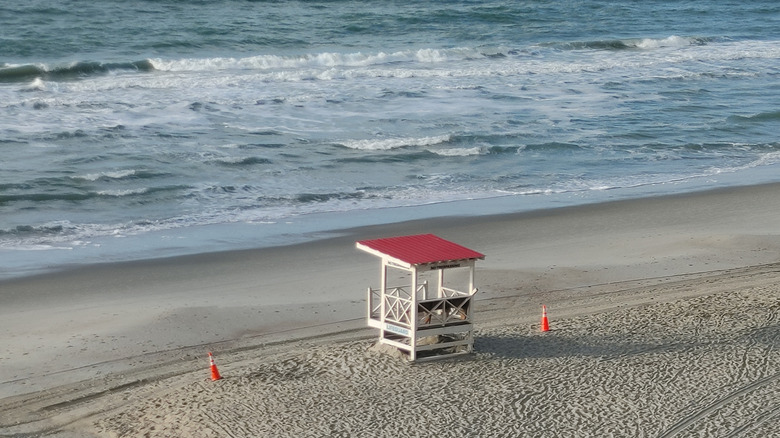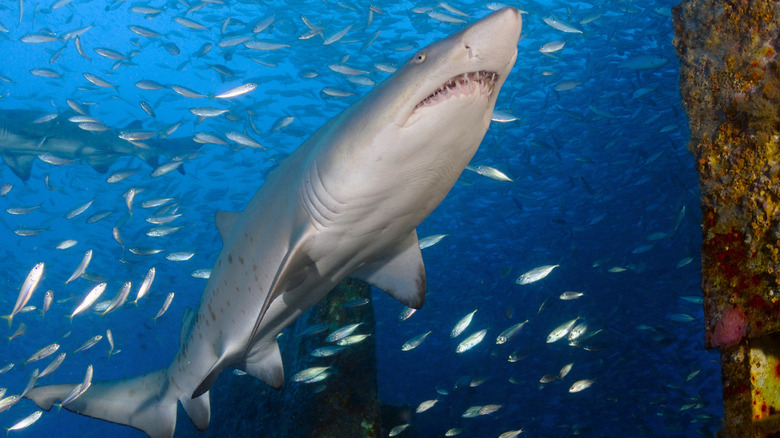One Of South Carolina's Most Shark-Filled Beaches Is Not For The Faint Of Heart
Hilton Head Island is the quintessential place for the perfect South Carolina beach vacation. However, before you jump in, you might want to know that you'll be sharing the waters with wildlife. Sea turtles and dolphins delight swimmers, but stingrays and jellyfish? Not so much. Then, there are the sharks. Recently, one particular beach has had more sightings — and bites — than others: Sea Pines Beach near Coligny Beach Park.
In June 2025, two bites were reported within a week of each other on and around this beach. While this isn't a good start to the summer season, it's not that unusual either. In general, Hilton Head averages about two or three shark bites a summer, sometimes more, depending on weather and wildlife conditions. Many occur in the waters off the southern end of the island facing the Atlantic, just off Sea Pines Beach.
Sea Pines is perhaps best known for the Harbour Town Golf Links, played on the PGA tour (which is why many come to this resort area for its golf greens, bikeable beaches, and dolphin tours). However, dozens of shark species also inhabit the waters off Sea Pines Beach, including the occasional great white or hammerhead. Only 13 or so species usually swim near beaches in the summer months, when warmer waters draw fish closer to shore. Atlantic sharpnose sharks are commonly caught by anglers in the surf. These small sharks are under 4 feet long, posing little danger to humans. Medium-sized sharks, like blacktips, are also frequently seen in these waters, chasing after small bait. Blacktip sharks are the suspected culprits behind recent bites. Shark experts say it can happen when humans blunder into a school of fish and the shark mistakenly chomps down on a human hand or foot.
What happens when a shark is sighted at Sea Pines Beach?
The island's Shore Beach Service patrols 13.5 miles of beach year-round on the island, including the Sea Pines area. In summer, it has more than 60 lifeguards constantly on the lookout for any telltale signs. When a lifeguard sees shark activity, the whistle is blown, and all swimmers are called out of the water. A red flag means no swimming is allowed for at least half an hour after the last sighting. This protocol is followed for every shark sighting. If a swimmer is bitten, lifeguards are trained to evacuate the injured swimmer to safety and treat the wound as ambulances arrive.
Shark bites are rare, but there are ways to make the odds even slimmer. First, try not to look like shark food. That means, no shiny or bright clothing that can look like fish glinting in the water, and even tattoos are one of the surprising things that may attract sharks. Stay out of the water at dusk or dawn when sharks are most active. If you see fishing by the beach, stay away. Sharks may lurk nearby, hoping for a meal. Don't swim too far out and stay in groups, as this is likely to scare away any sharks. Take a tip from lifeguards and keep an eye out for unusual fish activity. If you see a bait ball — a tight, ball-like group of fish — you should stay away, since this is a defensive move to escape predators. If you do find yourself within the sights of a shark, don't look away, as staring a shark down is one way to let the animal know you are not prey to be eaten. Some ocean lovers, especially surfers, use electric or chemical shark deterrents, but it's not clear how effective these gadgets really are.

